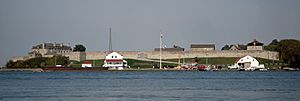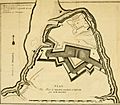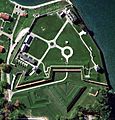Fort Niagara facts for kids
|
Colonial Niagara
|
|
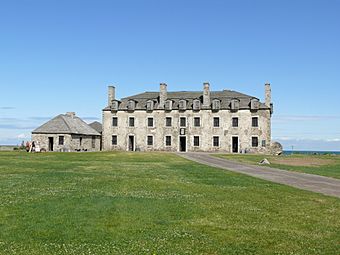
View of French Castle at Fort Niagara
|
|
| Location | Fort Niagara State Park, Porter, Niagara County, New York, USA |
|---|---|
| Nearest city | Youngstown, New York |
| Area | 250 acres (100 ha) |
| Built | 1726 |
| NRHP reference No. | 66000556 |
Quick facts for kids Significant dates |
|
| Added to NRHP | October 15, 1966 |
| Designated NHL | October 9, 1960 |
| Fort Niagara | |
|---|---|
| Youngstown, New York | |
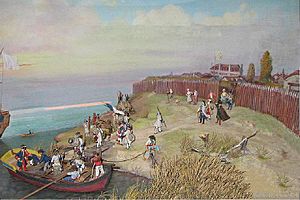
Fort Niagara 1728
|
|
| Type | Trading Post |
| Site information | |
| Controlled by | France 1678–1759 Great Britain 1759–1796 U.S. Army 1815–1963 U.S. Coast Guard 1963–present |
| Site history | |
| Built | 1678 |
| In use | 1726–present |
| Battles/wars | French and Indian War
Bradstreet's Expedition The War of 1812 |
| Garrison information | |
| Past commanders |
Louis-Thomas Chabert de Joncaire (1720–1726) John W. Heavey (1916–1917) |
Fort Niagara is a very old fort located in Youngstown, New York. It sits right where the Niagara River meets Lake Ontario. This spot was super important because it controlled who could travel between the Great Lakes and other areas.
The fort was first built by the French to protect their lands in North America. Later, the British took control of it during a big war. Even after the United States became independent, the British stayed at the fort for a while. Today, Fort Niagara is a state park and museum. You can visit it to learn about history and even see people dressed up in old uniforms!
Contents
Building Fort Niagara
The very first building at this spot was called Fort Conti. It was built in 1678 by a French explorer named René-Robert Cavelier, Sieur de La Salle.
A few years later, in 1687, the Governor of New France, the Marquis de Denonville, built a new fort here. He named it Fort Denonville. About a hundred soldiers were stationed there. However, the winter was very harsh, and many soldiers got sick. Almost all of them died before help arrived from Montreal. Because of this, the fort was abandoned in 1688, and its walls were taken down.
In 1726, the French built a new, stronger building on the same site. It was a two-story stone house designed by a French engineer. They called it the "House of Peace" or a trading post. This name was used to make the Haudenosaunee (a group of Native American nations) feel more comfortable. They wanted to trade with them. The name "The French Castle," which we use today, didn't become popular until much later.
The fort was made even bigger in 1755. This happened because there was growing tension between the French and British. Both countries wanted more land and control in North America.
British Take Control
Fort Niagara played a huge role in the French and Indian War. This war was fought between the British and the French, along with their Native American allies. In July 1759, the British attacked Fort Niagara. This attack was called the Battle of Fort Niagara.
The British surrounded the fort for nineteen days. A group of French soldiers who were coming to help the fort were ambushed by the British. Because of this, the French commander, Francois Pouchot, had to surrender the fort to the British. The British commander was Sir William Johnson, 1st Baronet. He became the leader of the British forces after their original general was accidentally killed during the siege.
The British kept control of Fort Niagara for the next 37 years. During the American Revolutionary War, Fort Niagara was a base for British soldiers and their allies. A group called Butler's Rangers, who supported the British, used the fort. An American officer, Lt. Col. William Stacy, was even held captive at Fort Niagara in 1779.
After the American Revolutionary War ended in 1783 with the Treaty of Paris, Fort Niagara was supposed to go to the United States. However, the British didn't leave right away. They stayed for 13 more years! Finally, after a new agreement called the Jay Treaty was signed, American forces took over the fort in 1796.
Fort Niagara in the War of 1812
During the War of 1812 between the United States and Great Britain, Fort Niagara was attacked again. On December 19, 1813, British forces captured the fort. This was in response to American forces burning a nearby Canadian town. The British held the fort until the war ended with the Treaty of Ghent. Since then, Fort Niagara has always been under United States control.
Many American and British army units that fought at Fort Niagara during the War of 1812 still exist today.
Later Uses of the Fort
The name "Old Fort Niagara" helps us tell the difference between the original fort and a newer military camp built nearby. After the American Civil War, armies stopped using old stone forts. They started building military camps with different designs. The "New Fort Niagara" had a large rifle range and was close to important industrial areas.
Fort Niagara was used to train soldiers for the Spanish–American War and World War I. During World War II, it was a place where new soldiers joined the army. It also became a POW camp for about 1,200 German soldiers captured in North Africa. After World War II, the fort even provided temporary homes for soldiers returning from the war.
During the Korean War, Fort Niagara was a headquarters for anti-aircraft weapons and later for Nike missiles. These missiles were used to defend against enemy aircraft. The United States Coast Guard still has a presence at Fort Niagara today. This makes Fort Niagara one of the longest continuously used military bases in the United States, from 1726 to the present day!
In 1931, a group called the Old Fort Niagara Association started working to preserve and operate the fort. In 1960, Fort Niagara was recognized as a National Historic Landmark. This means it's a very important historical site in the United States.
Fort Niagara Today
Today, Fort Niagara has been restored and is open to the public as Fort Niagara State Park and Museum. It's a great place to learn about history.
Visitors can often see historical reenactments. These are events where people dress up in old uniforms and act out battles and daily life from the 18th century. The fort also hosts special events like period dances and fundraisers. Fort Niagara is officially known as the Old Fort Niagara State Historic Site.
It was named a National Historic Landmark on October 9, 1960. The area around it, called the Colonial Niagara Historic District, was added to the National Register of Historic Places in 1966. It's a key part of the Niagara Falls National Heritage Area.
Images for kids
-
A historic cannon at Fort Niagara, pointing towards Toronto across Lake Ontario



